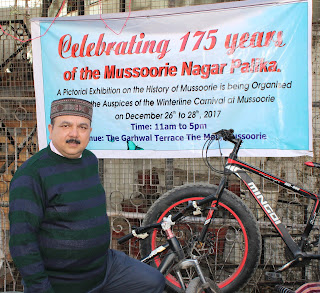My roving eye caught some very interesting sights this time which saw indifferent styles of parking areas carved out in the town. All these different parking areas display a totally wrong and illogical thinking of the executors.
Who could have imagined parking a four-wheeler or a two-wheeler on the busy Rajpur Road right at the Dilaram Bazar crossing (next to Water Works Building) in the middle of the road? Sound awkward isn’t it? Yes, it’s true, now two and four wheelers are being freely parked on the crossing in the newly carved out parking area.
It amazes, who are the think-tank who devices such schemes? Certainly these initiatives are funnily innovative and truly out of some junk box! Where on earth is parking done in the middle of a busy road and that to at a crossing?
As if the Dilaram Bazar intersection was too wide that a slice of the road here is now occupied by vehicle in the already congested space.
Imagine how unsafe will be for someone in the first place to slide his car in the so-called parking area along the busy Rajpur Road which has a continuous flow of heavy traffic with an equally congested crossing. Trying to squeeze in the parking along the road will definitely hinder the traffic however good the policing are since the traffic flow far exceeds the breadth of the road. Also chances are of vehicles bumping into each other at the slightest error.
Upon parking the passengers of the parked vehicle will again throw open another risk for self of crossing the road amidst the busy traffic.
This kind of parking at Dilaram Crossing on Rajpur Road can also lead to serious security issues as the intersection is one of the busiest and important ones where all the VIP, VVIP and senior government functionaries pass through several times a day while on way to the Governor’s House, Chief Minister House, the Circuit House, Survey of India and other important government and private establishments.
The same model of parking carved out at the busy Clock Tower area (along the Sardar Patel Park boundary and footpath). Here too not thinking of the tight road space and heavy traffic flow throughout the day a four-wheeler vehicle parking space created. This is a big nuisance at the place which unfortunately is the heart of the city and anyone coming to Dehradun has to pass through this area. Instead of keeping heavy traffic flow easy without congestions a parking has squeezed the space and turning it into an accident prone zone.
Due to the parking at the Clock Tower a major part of the recently beautified Sardar Patel Park has gone invisible being blocked by parked vehicles. Likewise the footpath created for the pedestrians along the park is now conveniently occupied by beggars and daily wage workers as few pedestrian want to walk through a passage encroached by vehicles and unwelcome occupants. What a mess created by the so-called town planners and administration think-tanks!
Another very funny idea of parking carved out by the administration and/or the police department is the encroachment on the space outside the Exit gate of the GPO opening towards the Digvijay Cinema. Here even more unthinkable idea has been implemented. The GPO Exit gate is now shut and a two-wheeler parking carved here for exclusively women. A woman constable also guards this parking to make sure only women park their two wheelers here.
One cannot understand how can an “Exit” Gate of a public building like the GPO used by thousands of people daily be blocked or taken over for implementing some stupid idea. God forbid, if there is an emergency how will the people trapped in the GPO compound and building be evacuated from a single gate that too crowded by hawkers and market traffic? Has any body thought of this?
It is equally strange and surprising that the Post Master General whose office is also in the GPO building has not raised his voice against the shutting of their exit gate.
Take the case of the double layered big parking at the MDDA Complex right at Clock Tower which was created to accommodate hundreds of vehicles coming here. This parking is heavily misused. The main aim of this parking was to decongest the road all around the Clock Tower but with the new road side parking the old problem is regenerated.
One witnesses an interesting story here too. While most of the MDDA Complex parking remains full anytime you go simply because some people living in the vicinity and/or the occupants of the Complex have permanently parked their many vehicles 24x7x365 days. Is there no norm to see no permanent stationing of any vehicle allowed at a public parking space? The authorities should at least some time inspect the state of affairs of public property as good governance.
While it is good that the local administration and the police department is thinking of creating added parking space but not in an unsystematic way compromising safety and security. The law should intervene to scrap such unreasonable planning and schemes of the administration in the interest of all.
Undoubtedly, parking is one of the essential components of development plans of any city but not in the following ways:
1) Obstruction of traffic (Parking obstructing movement of vehicles on road)
2) Obstruction of pedestrian movement (Parking in pavements)
3) Parking in No-parking area/zone (Parking in areas prevented)
4) Wrongful parking (Parking in a wrongful way, Angular parking in Parallel parking areas)
The indifferent parking areas created in Dehradun mtch all the aforesaid points.
There are many other examples across Dehradun where indifferent parking areas created. The government should take up this issue on an urgent basis to bring things to order otherwise it will only repent if some unexpected happens because of these ridiculous ideas.






